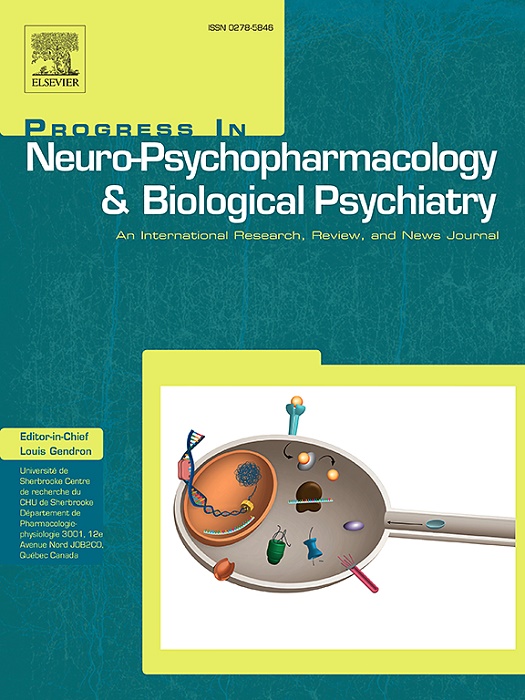先入为主的社会隔离对男性后代冒险行为和神经化学、神经内分泌和神经炎症标志物水平的影响。
IF 3.9
2区 医学
Q1 CLINICAL NEUROLOGY
Progress in Neuro-Psychopharmacology & Biological Psychiatry
Pub Date : 2025-09-16
DOI:10.1016/j.pnpbp.2025.111504
引用次数: 0
摘要
孕前期慢性应激对青春期子代的影响研究甚少。虽然冲动和冒险行为在青春期是生理性的,但它们可能是这一生命时期精神状况的关键症状。在这里,我们评估了被社会隔离的雌性大鼠的雄性后代从断奶到青春期在控制或隔离条件下(作为第二次压力打击)的冒险行为和认知功能障碍的可能发展。同时还评估了潜在的神经化学、神经内分泌和神经炎症改变。在社会孤立的雌性小鼠的青春期后代中发现,行走距离增加,在开阔场地中心和高架加迷宫的张开双臂中花费的时间增加,同时在墙壁上花费的时间减少,被动回避任务的潜伏期减少,新物体识别测试中的辨别指数降低。在怀孕前暴露于社会隔离的雌性所生的青春期大鼠的前额叶皮层中发现谷氨酸水平升高,GABA浓度降低,GLU/GABA比值增加,GFAP和cd11 β的表达增加,以及NGF量减少。与对照组相比,同一组的血浆催产素水平显著降低,抗利尿激素和催乳素浓度升高。总之,我们的研究结果指出,女性在孕前暴露于慢性社会压力中,可能通过改变神经化学、神经炎症和神经内分泌途径,导致青春期男性后代的冒险行为,从而确定青春期是预防和治疗方法的特定窗口。本文章由计算机程序翻译,如有差异,请以英文原文为准。
Effects of preconceptional social isolation on risk-taking behaviour and levels of neurochemical, neuroendocrine and neuroinflammatory markers in male offspring
The impact of chronic stress during the preconceptional period on the adolescent progeny has been poorly investigated. Although impulsivity and risk-taking behaviour are physiological during adolescence, they may represent key symptoms of psychiatric conditions of this life period.
Here, we evaluated the possible development of risk-taking behaviour and cognitive dysfunctions in the male offspring of socially isolated female rats, housed in control or isolation conditions (as second stressful hit) from weaning to adolescence. Underlying neurochemical, neuroendocrine and neuroinflammatory alterations were also assessed.
Increased distance travelled, time spent in the centre of an open field arena and in the open arms of an elevated plus maze were detected in the adolescent offspring of socially isolated females, together with reduced time spent in the wall, decreased latency time in the passive avoidance task and reduced discrimination index in the novel object recognition test. Elevations in glutamate levels, reduction of GABA concentrations, enhanced GLU/GABA ratio and expression of GFAP and CD11beta, as well as reduced NGF amount, were found in the prefrontal cortex of adolescent rats born from females exposed to social isolation before pregnancy. This same group showed a significant decrease of plasmatic oxytocin levels and enhanced vasopressin and prolactin concentrations, compared to controls.
In conclusion, our results point toward a detrimental effect of female exposure to chronic social stress during preconception in inducing risk-taking behaviour in the adolescent male offspring, possibly via alterations of neurochemical, neuroinflammatory and neuroendocrine pathways, thus identifying adolescence as a specific window for preventive and therapeutic approaches.
求助全文
通过发布文献求助,成功后即可免费获取论文全文。
去求助
来源期刊
CiteScore
12.00
自引率
1.80%
发文量
153
审稿时长
56 days
期刊介绍:
Progress in Neuro-Psychopharmacology & Biological Psychiatry is an international and multidisciplinary journal which aims to ensure the rapid publication of authoritative reviews and research papers dealing with experimental and clinical aspects of neuro-psychopharmacology and biological psychiatry. Issues of the journal are regularly devoted wholly in or in part to a topical subject.
Progress in Neuro-Psychopharmacology & Biological Psychiatry does not publish work on the actions of biological extracts unless the pharmacological active molecular substrate and/or specific receptor binding properties of the extract compounds are elucidated.

 求助内容:
求助内容: 应助结果提醒方式:
应助结果提醒方式:


